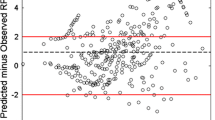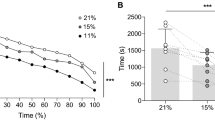Abstract
To examine whether the validity of perception-based intensity regulation would be affected by exercise duration, 20 subjects were recruited to complete a maximal exercise test (GXT) and four submaximal trials of varying duration and intensity using a cyle ergometer. During GXT, ratings of perceived exertion (RPE), oxygen uptake (VO2), heart rate (HR), and power output (PO) equivalent to 50 and 75% VO2peak were determined. During each trial, subjects were to produce and maintain a workload using RPE estimated at 50 or 75% VO2peak for 20 or 40 min, and VO2, HR, and PO were measured throughout the exercise. No differences in average VO2 were found between the estimation and production trial of either duration. However, average HR and PO were lower (P < 0.05) during the production trial of both durations. It appears that exercise duration has a minimal impact upon the accuracy of using RPE to regulate a target metabolic demand.



Similar content being viewed by others
References
American College of Sports Medicine (2000) General principles of exercise prescription. In: ACSM’s guidelines for exercise testing and prescription, 6th edn. Williams & Wilkins, Baltimore, pp 137–164
Bayles CM, Metz KF, Robertson RJ, Goss FL, Cosgrove J, McBurney D (1990) Perceptual regulation of prescribed exercise. J Card Rehabil 10:25–31
Bland JM, Altman DG (1986) Statistical methods for assessing agreement between methods of clinical measurement. Lancet 1:307–310
Borg GAV (1973) Perceived exertion: a note on “history” and methods. Med Sci Sports 5:90–93
Ceci R, Hassmen P (1991) Self-monitored exercise at three differenc RPE intensities in treadmill versus field running. Med Sci Sports Exerc 23:732–738. doi:10.1249/00005768-199106000-00013
Chow RJ, Wilmore JH (1984) The regulation of exercise intensity by ratings of perceived exertion. J Card Rehabil 4:382–387
Dunbar CC, Robertson RJ, Baun R, Blandin MF, Metz KF, Burdett R et al (1992) The validity of regulating exercise intensity by ratings of perceived exertion. Med Sci Sports Exerc 24:94–99. doi:10.1249/00005768-199201000-00016
Eston RG, Davis BL, Williams JG (1987) Use of perceived effort ratings to control exercise intensity in young healthy adults. Eur J Appl Physiol 56:222–224. doi:10.1007/BF00640648
Gaesser GA, Poole DC (1996) The slow component of oxygen uptake kinetics in humans. Exerc Sport Sci Rev 24:35–70. doi:10.1249/00003677-199600240-00004
Garcin M, Billat V (2001) Perceived exertion scales attest to both intensity and exercise duration. Percept Mot Skills 93:661–671. doi:10.2466/PMS.93.7.661-671
Garcin M, Vandewalle H, Monod H (1999) A new rating scale of perceived exertion on subjective estimation of exhaustion time: a preliminary study. Int J Sports Med 20:40–43. doi:10.1055/s-2007-971089
Glass SC, Knowlton RG, Becque MD (1992) Accuracy of RPE from graded exercise to establish exercise training intensity. Med Sci Sports Exerc 24:1303–1307. doi:10.1249/00005768-199211000-00017
Green JM, Crews TR, Bosak AM, Peveler W (2002) Physiological responses at 0 and 10% treadmill incline using the RPE estimation–production paradigm. J Sports Med Phys Fitness 42:8–13
Green JM, Crews TR, Pritchett RC, Mathfield C, Hall L (2004) Heart rate and ratings of perceived exertion during treadmill and elliptical exercise training. Percept Mot Skills 98:340–348. doi:10.2466/PMS.98.1.340-348
Gutmann MC, Squires RW, Pollock ML, Foster C, Anholm J (1981) Perceived exertion-heart rate relationship during exercise testing and training in cardiac patients. J Card Rehabil 1:52–59
Hagan RD, Weis SE, Raven PB (1992) Effect of pedal rate on cardiorespiratory responses during continuous exercise. Med Sci Sports Exerc 24:1088–1095. doi:10.1249/00005768-199210000-00004
Hamer M, Boutcher YN, Boutcher SH (2005) Effect of pedal rate and power output on rating of perceived exertion during cycle ergometry exercise. Percept Mot Skills 101:827–834. doi:10.2466/PMS.101.7.827-834
Herman CW, Nagelkirk PL, Pivarnik JM, Womack CJ (2003) Regulating oxygen uptake during high intensity exercise using heart rate and ratings of perceived exertion. Med Sci Sports Exerc 35:1751–1754. doi:10.1249/01.MSS.0000089336.33300.8E
Horstman DH, Morgan WP, Cymerman A, Stokes J (1979) Perception of effort during constant work to self imposed exhaustion. Percept Mot Skills 48:1111–1126
Kang J, Robertson RJ, Goss FL, DaSilva SG, Suminski RR, Utter AC et al (1997) Metabolic efficiency of arm cranking and leg cycling at the same mode-specific relative exercise intensity. Med Sci Sports Exerc 29:377–382. doi:10.1097/00005768-199703000-00013
Kang J, Chaloupka EC, Mastrangelo MA, Donnelly MS, Martz WP, Robertson RJ (1998) Regulating exercise intensity using ratings of perceived exertion during arm and leg ergometry. Eur J Appl Physiol 78:241–246. doi:10.1007/s004210050414
Kang J, Hoffman JR, Walker H, Chaloupka EC, Utter AC (2003) Regulating intensity using perceived exertion during extended exercise. Eur J Appl Physiol 89:475–482. doi:10.1007/s00421-003-0811-9
Kang J, Hoffman JR, Wendell M, Walker H, Hebret M (2004) Effect of contraction frequency on energy expenditure and substrate utilization during upper and lower body exercise. Br J Sports Med 38:31–35. doi:10.1136/bjsm.2002.002121
Marriott HE, Lamb KL (1996) The use of ratings of perceived exertion for regulating exercise levels in rowing ergometry. Eur J Appl Physiol 72:267–271. doi:10.1007/BF00838650
Mihevic PM (1981) Sensory cues for perceived exertion: a review. Med Sci Sports Exerc 12:150–163
Noble BJ (1982) Clinical applications of perceived exertion. Med Sci Sports Exerc 14:406–411
Noble BJ, Robertson RJ (eds) (1996) The role of RPE in graded exercise testing. In: Perceived exertion. Human Kinetics, Champaign, pp 215–255
Noble BJ, Metz KF, Pandolf KB, Cafarelli E (1973) Perceptual responses to exercise: a multiple regression study. Med Sci Sports 5:104–109
Pivarnik JM, Senay LC (1986) Effect of endurance training and heat acclimation on perceived exertion during exercise. J Card Rehabil 6:499–504
Raven P, Steven G (1998) Cardiovascular function during prolonged exercise. In: Lamb D, Murry R (eds) Perspectives in exercise science and sports medicine: prolonged exercise. Benchmark Press, Indianapolis, pp 43–71
Rejeski WJ, Ribisl PM (1980) Expected task duration and perceived effort: an attributional analysis. J Sports Psychol 2:227–236
Robertson RJ (ed) (2004) Traditional methods for rating perceived exertion. In: Perceived exertion for practitioners. Human Kinetics, Champaign, pp 21–32
Robertson RJ, Goss FL, Auble TE, Cassinelli DA, Spina RJ, Glickman EL et al (1990a) Cross-modal exercise prescription at absolute and relative oxygen uptake using perceived exertion. Med Sci Sports Exerc 22:653–659. doi:10.1249/00005768-199010000-00017
Robertson RJ, Stanko RT, Goss FL, Spina RJ, Reilly JJ, Greenawalt KD (1990b) Blood glucose extraction as a mediator of perceived exertion during prolonged exercise. Eur J Appl Physiol 61:100–105. doi:10.1007/BF00236701
Skinner JS, Hustler R, Bergsteinova V, Buskirk ER (1973) The validity and reliability of a rating scale of perceived exertion. Med Sci Sports 5:97–103
Smutok MA, Skrinar GS, Pandolf KB (1980) Exercise intensity: subjective regulation by perceived exertion. Arch Phys Med Rehabil 61:569–574
Thomas S, Reading J, Shepard RJ (1992) Revision of the physical activity readiness questionnaire (PAR-Q). Can J Appl Physiol 17:245–338
Acknowledgments
Authors are grateful to the subjects who participated in this study.
Author information
Authors and Affiliations
Corresponding author
Rights and permissions
About this article
Cite this article
Kang, J., Chaloupka, E.C., Biren, G.B. et al. Regulating intensity using perceived exertion: effect of exercise duration. Eur J Appl Physiol 105, 445–451 (2009). https://doi.org/10.1007/s00421-008-0922-4
Accepted:
Published:
Issue Date:
DOI: https://doi.org/10.1007/s00421-008-0922-4




